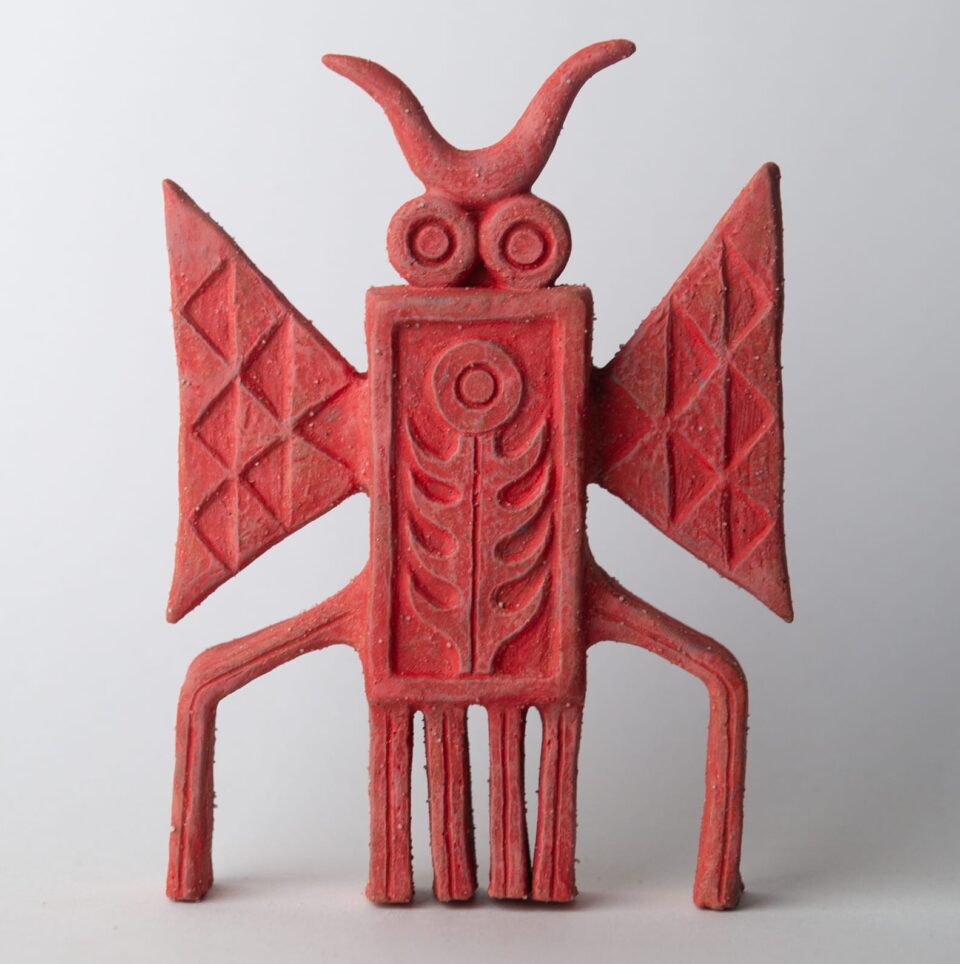The Midwestern painter, who developed an Abstract Expressionist practice away from New York’s buzzy circles, is now in her 90s and defying expectations of what an artist should be.
Through Gestural Oil Paintings, Maria Calandra Guides Her Stream of Consciousness Onto Canvas — Colossal
From Maine to Florida, artist Maria Calandra finds inspiration in nature for her dynamic oil landscapes.
Wood Heat – by Cool Tools Lab – Tools for Possibilities
Tools for Possibilities: issue no. 104
Source: Wood Heat – by Cool Tools Lab – Tools for Possibilities
Bernie Kaminski – Forever Magazine
MonkeyBird’s Majestic Murals Bend Time Through Elaborately Stenciled Compositions — Colossal



MonkeyBird is known for their large-scale stenciled murals rich with symbolism, architectural structures, and elaborate motifs.
Source: MonkeyBird’s Majestic Murals Bend Time Through Elaborately Stenciled Compositions — Colossal
Work | Jessica Vollrath
Spring Roll Dream on Vimeo
Directed by Mai Vu (10′ – 2022) Produced by The National Film & Television School Lights on Women Award – Cannes Film Festival 2022 A Vietnamese…
Source: Spring Roll Dream on Vimeo
Fantastical Totems Emerge from Clay in Yu Maeda’s Vibrant Sculptures — Colossal
Pop art iconography, nature, Japanese imagery, and ancient symbols merge in Yu Maeda’s vibrant ceramic sculptures.
Source: Fantastical Totems Emerge from Clay in Yu Maeda’s Vibrant Sculptures — Colossal
These companies are creating food out of thin air | MIT Technology Review
A new crop of biotech startups are working on an alternative to alternative protein.
Some of these companies are focused on industrial animal feed, fish meal, and pet food—products with slimmer profit margins but less exacting consumers and fewer regulatory hurdles. Human food, however, is where the real money—and impact—is. That’s why several companies, like Dyson’s Air Protein, are focused on it. In 2023 Air Protein opened its first “air farm” in San Leandro, California, a hub for the commercial food production industry, and announced a strategic development agreement with one of the largest agricultural commodity traders in the world, ADM, to collaborate on research and development and build an even larger, commercial-scale plant. The company’s “Air Chicken” (which, to be clear, is not actual chicken) is slowly making its way toward grocery store shelves and dinner tables. But that’s only the beginning. Other companies are making progress at harnessing bacteria to spin air into protein, too—and someday soon, these microbial protein patties could be as common as veggie burgers.
An alternative to alternative proteins
The environmental case for microbial protein is clear enough; it’s a simple calculus of arable land, energy, and mouths to feed. The global demand for protein is already at an all-time high, and with the population expected to grow to 9.7 billion by 2050, traditional agriculture will have a hard time keeping up, especially as it battles climate change, soil degradation, and disease. A growing global middle class is expected to raise levels of meat consumption, but factory-farmed meat is one of the leading drivers of greenhouse-gas emissions. Although protein-rich alternatives like soy are far more sustainable, most of the soy grown in the world is destined for use as animal feed—not for human consumption.
In contrast, bacterial “crops” convert carbon dioxide directly into protein, in a process that uses much less land and water. Microbial protein “farms” could operate year-round anywhere renewable electricity is cheap—even in places like Chile’s Atacama Desert, where farming is nearly impossible. That would take the strain off agricultural land—and potentially even give us the chance to return it to the wild.
“We are liberating food production from the constraints of agriculture,” Juha-Pekka Pitkänen, cofounder and CTO of the Finnish startup Solar Foods, explained in a recent company video. In April 2024 Solar Foods opened a demonstration factory in Vantaa, a short train ride from the Helsinki airport. It’s here, at Factory 01, that the company hopes to produce enough of its goldenrod-yellow protein powder, Solein, to prove itself viable—some 160 metric tons a year.
Source: These companies are creating food out of thin air | MIT Technology Review
Part 4 Nutrition and Strength for Aging Strong
The habit of consuming a nutrient rich diet along with building a physically active lifestyle is one of the best marriages we can embrace in today’s fast paced, stress-filled world. As the demand for greater output goes up we should be matching it with sufficient input to preserve our resilience to the stressors we encounter each day.
Building high quality muscle takes a daily effort of eating sufficient bioavailable protein as well as loading the muscle to provide the stimulus for growth. A big culprit for losing our physical abilities as we grow older is the age-related loss of muscle mass and strength which is called sarcopenia. Typically, muscle mass and strength increase steadily from birth and reach their peak at around 30 to 35 years of age. The RDA for protein is 0.8g/kg/day, but several studies suggest that higher protein consumption than the RDA is required to preserve muscle mass and function in the elderly (1). When it comes to protein quality, plant-based protein is generally of lower quality with a lower amino acid profile and reduced bioavailability (2). Essential amino acids (EAAs) are known to increase muscle protein synthesis. This is especially true for a high proportion of leucine is important for optimal stimulation of muscle protein synthesis (3). This science, though empowering, can get overwhelming and very expensive quite quickly when you consider budgeting for both food and supplementation on a regular basis. In this article we want to show you how to utilize the science and give you some ideas on eating and moving to build muscle and avoid age-related decline in function.
Considering the paragraph above, we know that the science tells us that we need to consume sufficient protein beyond the RDA, especially as we move into middle age. Current evidence suggests intakes in the range of at least 1.2 to 1.6 g/kg/day of high quality protein is a more ideal target for achieving optimal health outcomes in adults. Although a position stand in the International Society of Sports Nutrition shared that 1.4-2.0 g protein/kg body weight /day is sufficient for most exercising individuals (5).
When you combine an active lifestyle with sufficient loading, you absolutely can stave off the decline in functional capacity that occurs because of under-nourishing and under-loading along with a stressful lifestyle. Fortunately, US Wellness Meats has us covered with a wide range of high protein resources that we can access. Collagen is another very important term related to protein that we need to discuss before moving on to implementation. Collagen is protein molecules made up of amino acids. It provides structural support to your all important connective tissues. Collagen is resistant to stretching (that’s a good thing), so it is the perfect matrix for skin, tendons, bones and ligaments.
Collagen rich proteins include:
- Skin on chicken
- Beef roasts
- Chuck roast
- Shoulder roast
- Bone broth
- Salmon
- Spare ribs
- Beef short ribs
- Beef brisket
- Oxtail
- Chicken wings
Protein serving sizes, generally 2-3 ounces of poultry, beef or fish is about the size of a deck of cards. Using US Wellness Meats as your resource, here are some top favorite high quality animal proteins that are also high in collagen that will help you to build a more resilient you!
Here are some favorite meal combos:
Corned Beef Brisket along with eggs, cherries and sauteed spinach
Beef Chuck Roast in a wrap with peppers and onions
Pork broth made with pig ears and pig feet used to make a White Soup with Pork and Kale (swap the chicken broth for pork broth)
Pork Shoulder Roast with sweet potato and swiss chard
Lamb Rib Chops with baked potato and roast broccoli
Lamb Osso Bucco and Sweet Potato Risotto
Beef Short Ribs with your favorite 3 bean salad recipe
Beef Center Cut Shoulder Roast with roast potato and spinach salad
Chicken Feet and chicken necks chicken broth made into savory oats or lentils
This is a short list of the many options that we have available to us through US Wellness Meats!
NOW, as movement professionals we want to tell you how combining a high protein diet, rich in collagen with an active lifestyle will prompt the building of a more resilient you. Traditionally we think of building muscle mass and strength through weight lifting in a progressive loading program. That still holds true, we need to load the tissue to cause a breakdown and then remodel the tissue to get stronger. But, if we integrate the concept of microdosing movement that we shared in part 3, we can take this concept of building strength one step further. We can utilize microdosing movement to extend the benefits of your traditional strength workout by adding small doses of movement throughout the day.
Adding small doses of strength training throughout the day is not uncommon for most people who have manual labor jobs. Farmers, construction workers, gardeners or landscapers all spend some time either producing forces or resisting forces in their jobs. It may not look like traditional strength training but don’t be fooled. Those people that engage in smaller doses of exercise more frequently throughout the day are strong and preserve their functional capacities when they eat protein.
Strength and muscle growth is essential to function. When you load the body against gravity and with an external resistance (your body or tool) the tissues of the body receive those forces. As the tissues continue to be loaded frequently and consistently the body will need protein and collagen to fortify muscle and connective tissue.
Science has shown us that repeated loading of muscle and connective tissues in a lengthened under load environment has the greatest impact on preventing sarcopenia and increasing muscle hypertrophy. An example of being lengthened under load is hanging from a bar, or lowering a weight slowly or performing a task like shoveling. When we exercise with loads in multiple directions the body requires collagen to fortify the connective tissue. Connective tissue gets stronger when loading (this is called Mechanotransduction – process of converting mechanical energy into chemical activity) with different loads, directions, angles and speeds. In terms of total amount of exercise, known as volume and duration, most of the research tells us that 12-50 sets of structured exercise throughout the week will be beneficial for muscle hypertrophy. When you break it down into micro-doses you could do strength training for 7 minutes at a time (7sets) 3 times throughout the day = 21 sets per day. 21 sets per day of a particular muscle group or task one day per week would certainly provide an environment conducive for muscle growth. Imagine if you did that every day? Exercising 21 minutes of focused strength training per day will be a great way to enhance your strength and function. As professional coaches we ask our clients to try to commit to 7 minutes of strength training daily. Then we slowly progress your volume and complexity of movement over time.
Here is a sample workout along a similar style to Seven Movements which offers micro dosing prescriptions. This workout gives you a little metabolic boost, long lines of reach and some integrated breathwork. This is the type of stimulus that helps with recovery, extension of a training session and blood flow to the tissues to support growth.
Health and resilience practices as we age must bring together multiple inputs. This article introduced two huge inputs that you can begin to incorporate today. Stay tuned for part 5, but in the meantime, head over and subscribe to Seven Movements on YouTube for more content!












